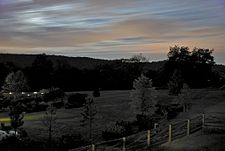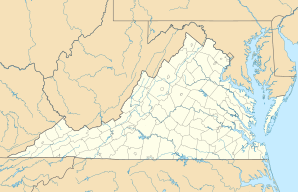Lovettsville
| Lovettsville | ||
|---|---|---|
 Lovettsville by night |
||
| Location in Virginia | ||
|
|
||
| Basic data | ||
| State : | United States | |
| State : | Virginia | |
| County : | Loudoun County | |
| Coordinates : | 39 ° 16 ′ N , 77 ° 38 ′ W | |
| Time zone : | Eastern ( UTC − 5 / −4 ) | |
| Residents : | 853 (status: 2000) | |
| Population density : | 370.9 inhabitants per km 2 | |
| Area : | 2.3 km 2 (approx. 1 mi 2 ) of which 2.3 km 2 (approx. 1 mi 2 ) is land |
|
| Height : | 154 m | |
| Postal code : | 20180 | |
| Area code : | +1 540 | |
| FIPS : | 51-47208 | |
| GNIS ID : | 1495879 | |
| Website : | www.townoflovettsville.com | |
Lovettsville is a city in Loudoun County in the US state of Virginia . At the 2000 census , Lovettsville had 853 people.
geography
Lovettsville is located 15 miles southwest of Frederick, Maryland and approximately 41 miles northwest of Washington, DC
The average altitude is 151 meters.
history
Beginnings
When East Coast colonists began moving west in the second half of the 17th century, the Iroquois were residents of an area that stretched south from New York through Pennsylvania and Maryland to northern Virginia . The colonists and other Indians feared them as well. In 1722, the governor of Virginia, Sir Alexander Spotswood, met with the governors of the states of New York and Pennsylvania to complete the Treaty of Albany with the Iroquois. The Blue Ridge Mountains were established as a buffer zone between the Indians and the white settlers. After 1722, the Indians played only a minor role in the history of northern Virginia.
The German Settlement
Around 1732, the first German families founded the settlement that later became Lovettsville. After arriving in America, many German immigrants moved to New York, with many more settling in Pennsylvania, where around 50,000 built houses between 1702 and 1727. In 1747, 60 percent of all Pennsylvania residents were Germans. They became known as the "Pennsylvania Dutch". After settlements opened in the Shenandoah Valley in Virginia from 1730, many Pennsylvania Dutch moved south to build houses and communities there. This valley was just a few miles west of what is now Lovettsville. About a year later, 65 families moved to the area that now surrounds Lovettsville. It is not known what the families called their settlement, but it was soon referred to by strangers as "The German Settlement". This name remained unchanged for about 100 years.
The settlers had decided to become citizens of Virginia, but continued to live as they did in Germany. They spoke only German and followed their traditional customs and refused to depend on others. They were geographically and socially separated from the English settlements in the south and east and were still Germans. In contrast to the colonial costumes of the English settlements in Virginia, the residents of the German Settlement dressed very simply with self-made clothes. Reasons for their decision to become a Virginian included a. the availability of fertile land.
They decided to move from the Pennsylvania colony, which had offered religious freedom since William Penn , to Virginia, where there was no separation between church and state. Everyone had to be a member of the Church of England . Nevertheless, the German Settlement ignored the orders of the church and state and founded their own Reformed Church, which played an important role in the early days of the settlement. The church leaders also served as teachers. Since there was no public education at the time, the church leaders made sure that all children were taught to read, write and do arithmetic.
Life in German Settlement was simple, but not primitive. The houses, churches and other buildings were log cabins, but not necessarily “small, immature and rough”, as border settlements are often described. Some of the log cabins still in existence in the Lovettsville area today were quite comfortable indeed.
The English colonists, who were well-dressed, danced the minuet, wore wigs, and kept slaves, often viewed their German neighbors as stupid and rabble. The Germans did nothing to change that impression. They also cared little what others thought of their simple clothes, their country manners, and their guttural pronunciation, as long as they lived in freedom, secluded from others in their small village.
Influences of the wars
The French and Indian War (1754–1763) took place only a few kilometers from the settlement, and there were no fights in the German Settlement. Many Pennsylvania Dutch who wanted to live in peace moved to what is now Lovettsville. Some German Lutherans joined them around 1765.
During the American War of Independence , many British returned to their homeland or fled to Canada . Almost all adult men were on the side of the patriots and volunteered to fight.
City foundation
After the war, everyday life in the settlement returned to its pre-war origins. In 1820, David Lovett, a successor to one of the first settler families, divided the area into quarter-acre parcels (about 1,000 square meters). This sparked a construction and business boom. The settlement was entered on maps as an independent village. It was called Newtown until 1828 , after which it was officially renamed Lovettsville. In 1836 Lovettsville was recognized as a city by the Virginia General Assembly, but it did not take until 1876 for full incorporation to take place.
education
Lovettsville has one elementary school, the Lovettsville Elementary School.
